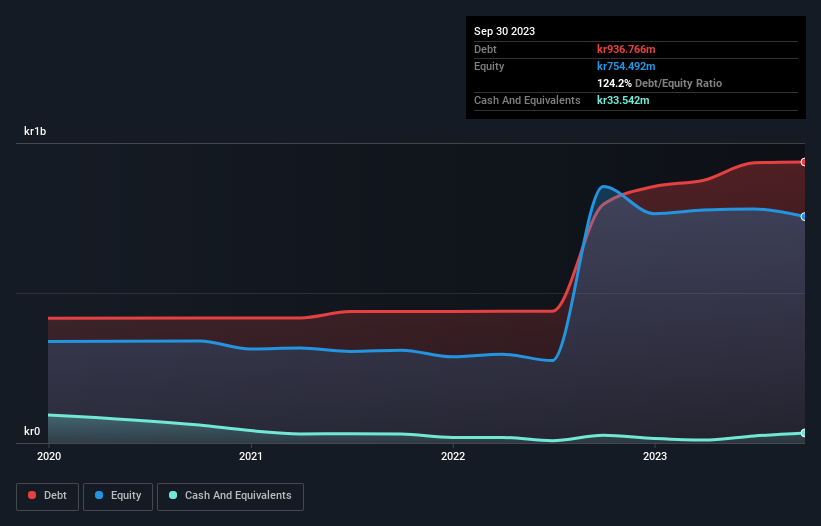- Sweden
- /
- Real Estate
- /
- OM:TINGS A
Does Tingsvalvet Fastighets (NGM:TINGS A) Have A Healthy Balance Sheet?

David Iben put it well when he said, 'Volatility is not a risk we care about. What we care about is avoiding the permanent loss of capital.' It's only natural to consider a company's balance sheet when you examine how risky it is, since debt is often involved when a business collapses. We can see that Tingsvalvet Fastighets AB (publ) (NGM:TINGS A) does use debt in its business. But should shareholders be worried about its use of debt?
When Is Debt Dangerous?
Generally speaking, debt only becomes a real problem when a company can't easily pay it off, either by raising capital or with its own cash flow. If things get really bad, the lenders can take control of the business. While that is not too common, we often do see indebted companies permanently diluting shareholders because lenders force them to raise capital at a distressed price. By replacing dilution, though, debt can be an extremely good tool for businesses that need capital to invest in growth at high rates of return. The first step when considering a company's debt levels is to consider its cash and debt together.
View our latest analysis for Tingsvalvet Fastighets
How Much Debt Does Tingsvalvet Fastighets Carry?
The image below, which you can click on for greater detail, shows that at September 2023 Tingsvalvet Fastighets had debt of kr936.8m, up from kr794.8m in one year. However, because it has a cash reserve of kr33.5m, its net debt is less, at about kr903.2m.

A Look At Tingsvalvet Fastighets' Liabilities
We can see from the most recent balance sheet that Tingsvalvet Fastighets had liabilities of kr544.1m falling due within a year, and liabilities of kr456.8m due beyond that. Offsetting these obligations, it had cash of kr33.5m as well as receivables valued at kr18.3m due within 12 months. So its liabilities outweigh the sum of its cash and (near-term) receivables by kr949.1m.
This deficit casts a shadow over the kr432.8m company, like a colossus towering over mere mortals. So we definitely think shareholders need to watch this one closely. After all, Tingsvalvet Fastighets would likely require a major re-capitalisation if it had to pay its creditors today.
In order to size up a company's debt relative to its earnings, we calculate its net debt divided by its earnings before interest, tax, depreciation, and amortization (EBITDA) and its earnings before interest and tax (EBIT) divided by its interest expense (its interest cover). This way, we consider both the absolute quantum of the debt, as well as the interest rates paid on it.
Weak interest cover of 2.3 times and a disturbingly high net debt to EBITDA ratio of 19.3 hit our confidence in Tingsvalvet Fastighets like a one-two punch to the gut. The debt burden here is substantial. However, it should be some comfort for shareholders to recall that Tingsvalvet Fastighets actually grew its EBIT by a hefty 136%, over the last 12 months. If it can keep walking that path it will be in a position to shed its debt with relative ease. There's no doubt that we learn most about debt from the balance sheet. But it is Tingsvalvet Fastighets's earnings that will influence how the balance sheet holds up in the future. So when considering debt, it's definitely worth looking at the earnings trend. Click here for an interactive snapshot.
Finally, a business needs free cash flow to pay off debt; accounting profits just don't cut it. So it's worth checking how much of that EBIT is backed by free cash flow. Looking at the most recent three years, Tingsvalvet Fastighets recorded free cash flow of 25% of its EBIT, which is weaker than we'd expect. That weak cash conversion makes it more difficult to handle indebtedness.
Our View
To be frank both Tingsvalvet Fastighets's net debt to EBITDA and its track record of staying on top of its total liabilities make us rather uncomfortable with its debt levels. But on the bright side, its EBIT growth rate is a good sign, and makes us more optimistic. Overall, it seems to us that Tingsvalvet Fastighets's balance sheet is really quite a risk to the business. For this reason we're pretty cautious about the stock, and we think shareholders should keep a close eye on its liquidity. The balance sheet is clearly the area to focus on when you are analysing debt. But ultimately, every company can contain risks that exist outside of the balance sheet. For example Tingsvalvet Fastighets has 4 warning signs (and 3 which can't be ignored) we think you should know about.
At the end of the day, it's often better to focus on companies that are free from net debt. You can access our special list of such companies (all with a track record of profit growth). It's free.
Valuation is complex, but we're here to simplify it.
Discover if Tingsvalvet Fastighets might be undervalued or overvalued with our detailed analysis, featuring fair value estimates, potential risks, dividends, insider trades, and its financial condition.
Access Free AnalysisHave feedback on this article? Concerned about the content? Get in touch with us directly. Alternatively, email editorial-team (at) simplywallst.com.
This article by Simply Wall St is general in nature. We provide commentary based on historical data and analyst forecasts only using an unbiased methodology and our articles are not intended to be financial advice. It does not constitute a recommendation to buy or sell any stock, and does not take account of your objectives, or your financial situation. We aim to bring you long-term focused analysis driven by fundamental data. Note that our analysis may not factor in the latest price-sensitive company announcements or qualitative material. Simply Wall St has no position in any stocks mentioned.
About OM:TINGS A
Tingsvalvet Fastighets
A real estate company, owns, manages, and leases office and commercial properties in Central Sweden.
Slight with questionable track record.
Market Insights
Community Narratives



